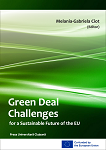The strategic importance of the Middle Corridor
for the EU as a key partner in Central Asia
and the competitive interests in the region
The strategic importance of the Middle Corridor
for the EU as a key partner in Central Asia
and the competitive interests in the region
Author(s): Paul-Alexandru Sitea
Subject(s): Environmental Geography
Published by: Presa Universitara Clujeana
Keywords: Middle Corridor; geopolitical competition; Eurasian connectivity;
Summary/Abstract: The Middle Corridor, which connects Europe and CentralAsia and spans the South Caucasus and the Caspian Sea, is an essentialgeopolitical and financial route. The EU policy to reduce reliance onRussian energy elements is based on this path, which is becoming morevital in diversifying power sources and improving change flows. Thisstrategy has been emphasized, considering sanctions have been placedon Iran and Russia (with the war on Ukraine). Large-scale infrastructureprojects, such as the “New Baku International Sea Trade Port,” demonstratethe corridor’s capability to guide tremendous alternate volumesand link-local economies. At the same time, boundaries regarding commoditytransit and domestic market effects still exist. The geopoliticalinterest in the Middle Corridor is not entirely European because the corridoris focused on the aid of China’s Belt and Road Initiative (BRI) as acritical part of its broader plan to develop complex geopolitical networksto help China become a global hegemon. That plan includes Eurasiaconnectivity in the first place. On the other hand, the European GlobalGateway challenge is much smaller, and the project that initiatives theEU’s interests in diversifying its energy imports and growing politicallinks within it can play a significant role on the international stage; themain objective for the EU in the competitive race with other great powers(mainly China) from this perspective is to enable the developmentof their regional and global status quo. The Middle Corridor has thepotential to have a major impact on Eurasian connectivity and is moreimportant for stabilizing the energy security sector of the EU’s actors.Its strategic functions are diverse, spanning geopolitical, economic, andenvironmental elements.
Book: Green Deal Challenges for a Sustainable Future of the EU
- Page Range: 265-274
- Page Count: 18
- Publication Year: 2024
- Language: English
- Content File-PDF

